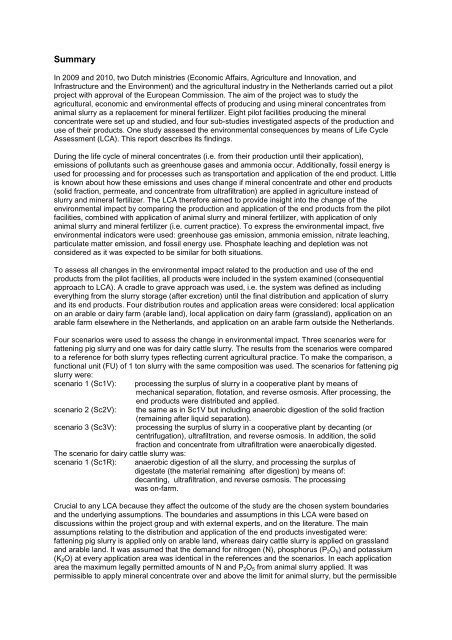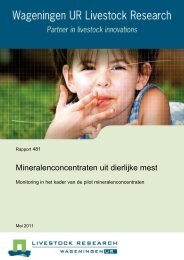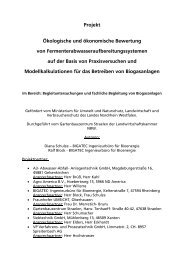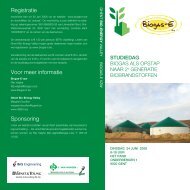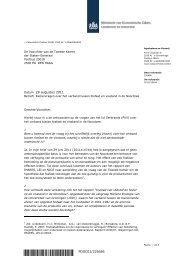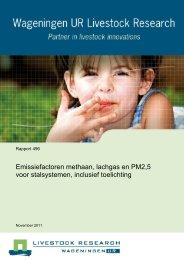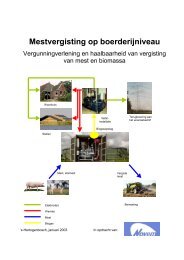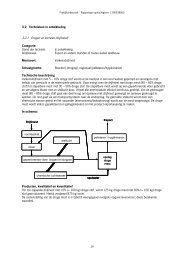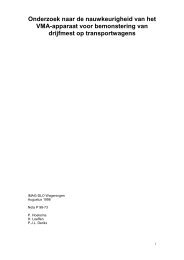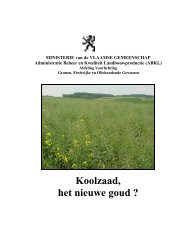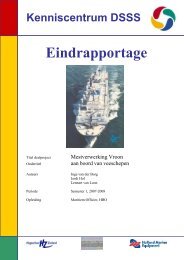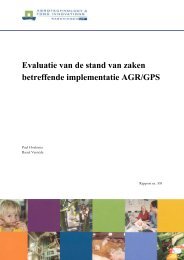Vries et al 2011. LCA Pilots Mineralenconcentraten Final (3)x
Vries et al 2011. LCA Pilots Mineralenconcentraten Final (3)x
Vries et al 2011. LCA Pilots Mineralenconcentraten Final (3)x
- No tags were found...
Create successful ePaper yourself
Turn your PDF publications into a flip-book with our unique Google optimized e-Paper software.
SummaryIn 2009 and 2010, two Dutch ministries (Economic Affairs, Agriculture and Innovation, andInfrastructure and the Environment) and the agricultur<strong>al</strong> industry in the N<strong>et</strong>herlands carried out a pilotproject with approv<strong>al</strong> of the European Commission. The aim of the project was to study theagricultur<strong>al</strong>, economic and environment<strong>al</strong> effects of producing and using miner<strong>al</strong> concentrates fromanim<strong>al</strong> slurry as a replacement for miner<strong>al</strong> fertilizer. Eight pilot facilities producing the miner<strong>al</strong>concentrate were s<strong>et</strong> up and studied, and four sub-studies investigated aspects of the production anduse of their products. One study assessed the environment<strong>al</strong> consequences by means of Life CycleAssessment (<strong>LCA</strong>). This report describes its findings.During the life cycle of miner<strong>al</strong> concentrates (i.e. from their production until their application),emissions of pollutants such as greenhouse gases and ammonia occur. Addition<strong>al</strong>ly, fossil energy isused for processing and for processes such as transportation and application of the end product. Littleis known about how these emissions and uses change if miner<strong>al</strong> concentrate and other end products(solid fraction, permeate, and concentrate from ultrafiltration) are applied in agriculture instead ofslurry and miner<strong>al</strong> fertilizer. The <strong>LCA</strong> therefore aimed to provide insight into the change of theenvironment<strong>al</strong> impact by comparing the production and application of the end products from the pilotfacilities, combined with application of anim<strong>al</strong> slurry and miner<strong>al</strong> fertilizer, with application of onlyanim<strong>al</strong> slurry and miner<strong>al</strong> fertilizer (i.e. current practice). To express the environment<strong>al</strong> impact, fiveenvironment<strong>al</strong> indicators were used: greenhouse gas emission, ammonia emission, nitrate leaching,particulate matter emission, and fossil energy use. Phosphate leaching and depl<strong>et</strong>ion was notconsidered as it was expected to be similar for both situations.To assess <strong>al</strong>l changes in the environment<strong>al</strong> impact related to the production and use of the endproducts from the pilot facilities, <strong>al</strong>l products were included in the system examined (consequenti<strong>al</strong>approach to <strong>LCA</strong>). A cradle to grave approach was used, i.e. the system was defined as includingeverything from the slurry storage (after excr<strong>et</strong>ion) until the fin<strong>al</strong> distribution and application of slurryand its end products. Four distribution routes and application areas were considered: loc<strong>al</strong> applicationon an arable or dairy farm (arable land), loc<strong>al</strong> application on dairy farm (grassland), application on anarable farm elsewhere in the N<strong>et</strong>herlands, and application on an arable farm outside the N<strong>et</strong>herlands.Four scenarios were used to assess the change in environment<strong>al</strong> impact. Three scenarios were forfattening pig slurry and one was for dairy cattle slurry. The results from the scenarios were comparedto a reference for both slurry types reflecting current agricultur<strong>al</strong> practice. To make the comparison, afunction<strong>al</strong> unit (FU) of 1 ton slurry with the same composition was used. The scenarios for fattening pigslurry were:scenario 1 (Sc1V):scenario 2 (Sc2V):scenario 3 (Sc3V):The scenario for dairy cattle slurry was:scenario 1 (Sc1R):processing the surplus of slurry in a cooperative plant by means ofmechanic<strong>al</strong> separation, flotation, and reverse osmosis. After processing, theend products were distributed and applied.the same as in Sc1V but including anaerobic digestion of the solid fraction(remaining after liquid separation).processing the surplus of slurry in a cooperative plant by decanting (orcentrifugation), ultrafiltration, and reverse osmosis. In addition, the solidfraction and concentrate from ultrafiltration were anaerobic<strong>al</strong>ly digested.anaerobic digestion of <strong>al</strong>l the slurry, and processing the surplus ofdigestate (the materi<strong>al</strong> remaining after digestion) by means of:decanting, ultrafiltration, and reverse osmosis. The processingwas on-farm.Cruci<strong>al</strong> to any <strong>LCA</strong> because they affect the outcome of the study are the chosen system boundariesand the underlying assumptions. The boundaries and assumptions in this <strong>LCA</strong> were based ondiscussions within the project group and with extern<strong>al</strong> experts, and on the literature. The mainassumptions relating to the distribution and application of the end products investigated were:fattening pig slurry is applied only on arable land, whereas dairy cattle slurry is applied on grasslandand arable land. It was assumed that the demand for nitrogen (N), phosphorus (P 2 O 5 ) and potassium(K 2 O) at every application area was identic<strong>al</strong> in the references and the scenarios. In each applicationarea the maximum leg<strong>al</strong>ly permitted amounts of N and P 2 O 5 from anim<strong>al</strong> slurry applied. It waspermissible to apply miner<strong>al</strong> concentrate over and above the limit for anim<strong>al</strong> slurry, but the permissible


